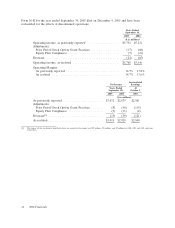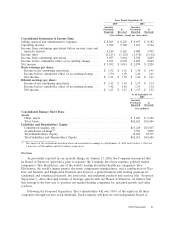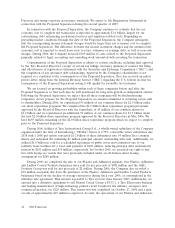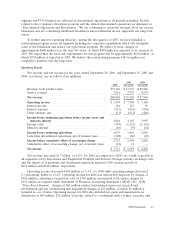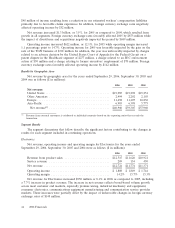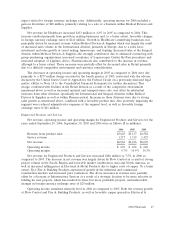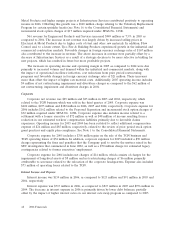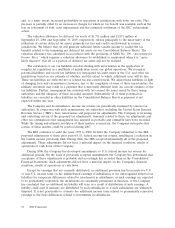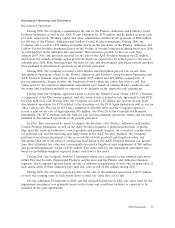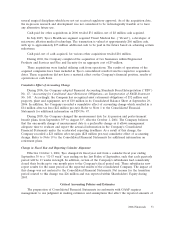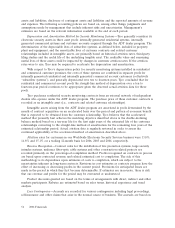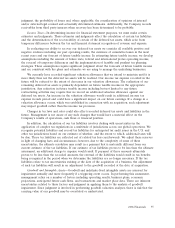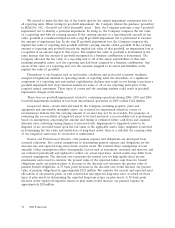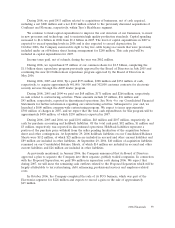ADT 2006 Annual Report Download - page 112
Download and view the complete annual report
Please find page 112 of the 2006 ADT annual report below. You can navigate through the pages in the report by either clicking on the pages listed below, or by using the keyword search tool below to find specific information within the annual report.and, to a lesser extent, increased profitability in operations in jurisdictions with lower tax rates. This
decrease is partially offset by an increase in charges for which no tax benefit was available such as the
loss on retirement of debt, asset impairments and the estimated settlement of the SEC enforcement
action.
The valuation allowance for deferred tax assets of $1,731 million and $1,871 million at
September 29, 2006 and September 30, 2005, respectively, relates principally to the uncertainty of the
utilization of certain deferred tax assets, primarily tax loss and credit carryforwards in various
jurisdictions. We believe that we will generate sufficient future taxable income to realize the tax
benefits related to the remaining net deferred tax assets on our Consolidated Balance Sheets. The
valuation allowance was calculated in accordance with the provisions of SFAS No. 109, ‘‘Accounting for
Income Taxes,’’ which requires a valuation allowance be established or maintained when it is ‘‘more
likely than not’’ that all or a portion of deferred tax assets will not be realized.
The calculation of our tax liabilities involves dealing with uncertainties in the application of
complex tax regulations in a multitude of jurisdictions across our global operations. We recognize
potential liabilities and record tax liabilities for anticipated tax audit issues in the U.S. and other tax
jurisdictions based on our estimate of whether, and the extent to which, additional taxes will be due.
These tax liabilities are reflected net of related tax loss carryforwards. We adjust these liabilities in light
of changing facts and circumstances; however, due to the complexity of some of these uncertainties, the
ultimate resolution may result in a payment that is materially different from our current estimate of the
tax liabilities. Further, management has reviewed with tax counsel the issues raised by these taxing
authorities and the adequacy of these recorded amounts. Substantially all of these potential tax
liabilities are recorded in other liabilities on the Consolidated Balance Sheets as payment is not
expected within one year.
The Company and its subsidiaries’ income tax returns are periodically examined by various tax
authorities. In connection with such examinations, tax authorities, including the United States Internal
Revenue Service (‘‘IRS’’), have raised issues and proposed tax adjustments. The Company is reviewing
and contesting certain of the proposed tax adjustments. Amounts related to these tax adjustments and
other tax contingencies that management has assessed as probable and estimable have been recorded.
While the timing and ultimate resolution of these matters is uncertain, the Company anticipates that
certain of these matters could be resolved during 2007.
The IRS continues to audit the years 1997 to 2000. In 2004 the Company submitted to the IRS
proposed adjustments to these prior period U.S. federal income tax returns, resulting in a reduction in
the taxable income previously filed. During 2006, the IRS accepted substantially all of the proposed
adjustments. These adjustments did not have a material impact on the financial condition, results of
operations or cash flows of the Company.
During 2006, the Company has developed amendments to U.S. federal income tax returns for
additional periods. On the basis of previously accepted amendments, the Company has determined that
acceptance of these adjustments is probable and accordingly has recorded them in the Consolidated
Financial Statements. Such adjustments did not have a material impact on the Company’s financial
condition, results of operations or cash flows.
Except for earnings that are currently distributed, no additional provision has been made for U.S.
or non-U.S. income taxes on the undistributed earnings of subsidiaries or for unrecognized deferred tax
liabilities for temporary differences related to investments in subsidiaries, as such earnings are expected
to be permanently reinvested, the investments are essentially permanent in duration, or the Company
has concluded that no additional tax liability will arise as a result of distribution of such earnings. A
liability could arise if amounts are distributed by such subsidiaries or if such subsidiaries are ultimately
disposed. It is not practicable to estimate the additional income taxes related to permanently reinvested
earnings or the basis differences related to investments in subsidiaries.
50 2006 Financials


